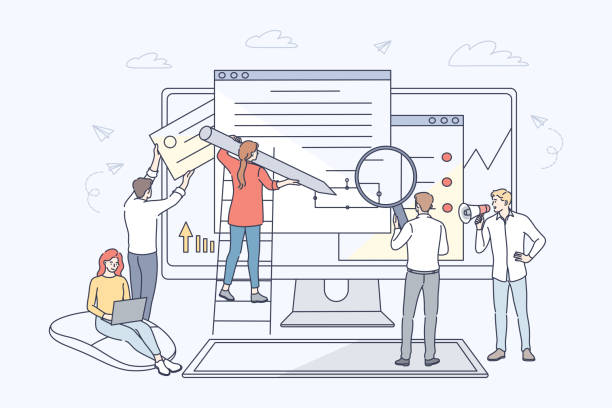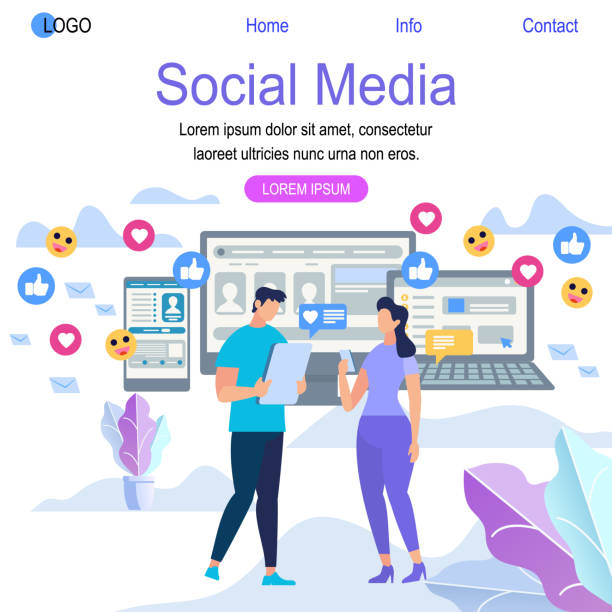Introduction to Modern UI Website Design: Definition and Importance

In today’s digital world, users’ first interaction with a business often occurs through its website.
Therefore, #UserExperience and #UserInterface play a vital role in creating a positive first impression.
The concept of modern UI website design goes beyond mere aesthetics; this approach focuses on creating a seamless, enjoyable, and efficient user experience.
A modern user interface is not only attractive and visual but also ensures easy navigation, quick responsiveness, and high accessibility.
The importance of this issue lies in the fact that an outdated and user-unfriendly website can lead to high bounce rates and the loss of potential customers, even if it contains valuable content.
In contrast, a modern design can gain user trust, increase conversion rates, and elevate your brand’s position in the audience’s mind.
This type of design helps websites stand out among competitors and send a clear message consistent with brand identity.
In fact, investing in an advanced user interface is an investment in the future of your business.
User Interface (UI) and User Experience (UX) are two inseparable components of this process, both of which must be designed with great care to meet user needs and expectations.
This explanatory section provides a foundation for a deeper understanding of subsequent concepts in this article and clarifies the importance of integrating these two concepts in website design with a modern approach.
Losing potential customers due to an unprofessional website? Rasaweb is your answer! With our specialized corporate website design services:
✅ Elevate your business’s credibility and standing
✅ Experience more targeted customer acquisition
⚡ Act now to receive a free consultation!
Key Principles of Modern User Interface and User Experience Design

To achieve modern UI website design, one must adhere to a set of key principles and rules that go beyond visual aspects and address the overall user experience.
One of the most important of these principles is Responsive Design.
In today’s world, where users access websites from various devices including smartphones, tablets, and desktops, your website must be able to automatically adapt to the screen size of each device and provide a consistent user experience.
The second principle is simplicity and minimalism.
Eliminating unnecessary elements and focusing on core content helps users find the information they need without confusion.
This ‘Less is More’ approach makes your website appear more professional and user-friendly.
Also, simplicity in navigation (Intuitive Navigation) is of high importance.
Users should be able to easily navigate the website and access its various sections; a consistent and logical structure for menus and links is essential.
Visual Feedback is another important principle; every user action, such as clicking a button or submitting a form, should be accompanied by appropriate visual feedback to assure the user that their operation was performed correctly.
Furthermore, the use of appropriate typography, harmonious colors, and high-quality graphics significantly contributes to visual appeal and improved user experience.
These specialized principles not only modernize your website visually but also dramatically enhance its performance and efficiency.
This educational approach, along with explaining the concepts, helps you better understand how to implement these principles in your next new UI website design project.
New Tools and Techniques in Modern UI Website Design

To realize modern UI website design, designers require a set of advanced tools and techniques that facilitate and optimize the design process.
Initially, UI/UX design software like Adobe XD, Figma, and Sketch are of high importance.
These tools enable the design of wireframes, interactive prototypes, and pixel-perfect user interfaces.
Figma has rapidly gained popularity due to its real-time team collaboration and cloud access, while Adobe XD also offers powerful tools for animation and creating complex prototypes.
New techniques also play a vital role in this process.
The use of Design Systems is one such technique, which includes a set of reusable components, patterns, and guidelines.
These systems not only increase design speed but also ensure consistency and coherence across the website or application.
Design Systems are particularly useful for large projects and multiple teams.
Additionally, the use of Motion Graphics and subtle animations can help improve the user experience by creating a sense of dynamism and guiding the user along the path.
These animations should be subtle and purposeful so as not to distract the user.
A/B testing is also an important analytical technique that helps designers evaluate the effectiveness of various UI elements and make data-driven decisions.
By using these tools and techniques, designers can create websites that are not only visually stunning but also unparalleled in functionality.
This specialized knowledge in the field of tools is essential for any web designer looking to implement advanced user interfaces.
A table of some of the most popular UI/UX design tools is provided below:
| Tool Name | Main Use | Key Features |
|---|---|---|
| Figma | UI Design, Wireframing, Prototyping, Team Collaboration | Web-based, real-time collaboration, various plugins |
| Adobe XD | UI/UX Design, Prototyping, Animation | Integration with Adobe ecosystem, strong animation capabilities |
| Sketch | UI and Vector Design (Mac only) | Focus on UI, large plugin community, shared libraries |
| InVision | Prototyping, Collaboration, Design Feedback | Creating interactive prototypes from static designs |
The Importance of User Research and Analysis in Modern Design

Before starting any modern UI website design work, conducting comprehensive research and analysis on target users is of paramount importance.
Without a deep understanding of user needs, behaviors, and expectations, website design may go in a direction that no one wants.
This stage, which is a crucial part of the UX process, involves collecting data through interviews, surveys, focus groups, and analysis of existing data (such as traffic statistics from similar websites).
The main goal of this research is to create User Personas, which represent hypothetical characters of your ideal users.
These personas include information such as age, occupation, goals, challenges, and behavioral patterns.
User personas help designers always keep user needs in mind when making design decisions.
In addition to personas, User Journey Mapping is also a powerful tool that shows what steps the user takes from the moment they enter the website until they reach their goal, and what emotions they experience at each stage.
Identifying Pain Points and opportunities for improvement along this path enables designers to create a frictionless and enjoyable experience.
This analytical and guidance-oriented approach ensures that the final website is not only beautiful but also completely user-centric and fulfills business objectives.
Did you know that overlooking this stage can lead to a waste of significant resources and time? Challenging content at this stage helps the design team to challenge their assumptions and ensure that the design is built upon real data.
Did you know that 85% of customers check your company’s website before any interaction?
With Rasaweb, build a corporate website worthy of your credibility.
✅ Increase customer credibility and trust
✅ Attract high-quality leads
⚡ Get a free website design consultation
Wireframing and Prototyping: From Idea to Implementation

After the user research and analysis phase, it’s time to transform identified ideas and needs into tangible structures.
Wireframing is the first step in this process.
Wireframes are simple, black-and-white layouts of website pages that show main elements like headers, menus, texts, images, and buttons.
The purpose of a wireframe is to focus on structure, information hierarchy, and user flow, without getting bogged down in visual details.
This stage helps designers and development teams agree on the website’s skeleton before spending time and money on full design.
Wireframes are typically created with tools like Balsamiq, Figma, or even with paper and pen.
After the wireframes are approved, the Prototyping phase begins.
Prototypes are interactive, semi-realistic versions of the website that allow users and stakeholders to interact with the UI and experience the user flow.
Prototypes can range from low-fidelity with minimal visual details to high-fidelity with complete details and precise animations.
The main goal of prototyping is to test and validate the design before the final development phase.
This stage helps identify navigation issues, weaknesses in the user flow, and improve the overall experience.
Testing prototypes with real users provides valuable feedback that can lead to iterations and design improvements.
This educational and explanatory process for modern UI website design ensures that the final product is not only beautiful but also efficient and user-friendly.
These stages do not proceed linearly and often involve multiple iterations and revisions to achieve the best result.
Did you know that prototyping can reduce redesign costs by up to 80% in later stages? This highlights the importance of this stage in optimizing the web design process.
Visual Design and Branding: The Role of Visual Identity in UI

Modern UI website design is not limited to functionality and usability but also includes visual aspects and brand identity.
Visual Design is a crucial element that evokes user emotions and directly impacts their perception of the brand.
Choosing an appropriate color palette, readable and beautiful fonts (typography), smart use of whitespace, and designing relevant icons and images all contribute to creating an attractive and cohesive visual experience.
Colors can evoke different emotions and influence user decisions; for example, blue conveys a sense of trust and professionalism, while green conveys a sense of growth and nature.
Therefore, color selection should be made considering the brand’s message and values.
Branding in web design means ensuring that every visual element on the website aligns with your overall brand identity.
This includes the use of logo, visual style, tone of voice, and even the type of user interaction.
A website with strong visual design consistent with the brand not only appears professional but also helps increase brand recognition and create a deeper connection with the audience.
The difference between an ordinary website and an exceptional one often lies in the attention to visual details and how the brand identity is reflected in every pixel.
This specialized aspect of design requires a deep understanding of the principles of aesthetics and the psychology of colors and forms.
Finally, producing high-quality visual content, from images and videos to animations, plays a crucial role in attracting and retaining user attention.
Poor visual design can render even the best content ineffective, while strong visual design can transform even simple content into a pleasant experience.
These entertaining yet specialized aspects are an integral part of modern and user-friendly web design.
Accessibility and Inclusivity in Modern User Interface Design

One of the most important yet often overlooked aspects of modern UI website design is Accessibility.
Accessibility means designing a website that everyone, regardless of their abilities or the tools they use to access the internet, can easily use.
This includes individuals with visual impairments (such as blindness and low vision), hearing impairments, motor disabilities, or cognitive impairments.
Considering accessibility from the outset is not only an ethical and sometimes legal requirement but also helps expand your audience reach and leads to improved SEO.
For example, using alt tags for images (which provide textual descriptions for images and are read by screen readers for blind individuals), ensuring sufficient contrast between text and background, using semantic HTML structure, and enabling keyboard navigation for users who cannot use a mouse, are all key principles of accessibility.
Inclusivity also means designing for a wide range of users with different cultural backgrounds, languages, and needs.
This approach ensures that your website is understandable and usable for everyone.
Did you know that neglecting accessibility can result in a significant portion of users being unable to use your website? This is a thought-provoking question that highlights the importance of this topic.
Adhering to the WCAG (Web Content Accessibility Guidelines) standards published by the World Wide Web Consortium (W3C) is the best guide for implementing accessibility.
These guidelines provide comprehensive recommendations for building accessible websites.
Adhering to these principles in modern web design not only transforms your website into a more welcoming place but also enhances your brand’s credibility and reputation.
Ultimately, inclusive design means creating a fair and equal experience for all users.
The table below shows some key items for improving website accessibility:
| Accessibility Element | Description | Purpose |
|---|---|---|
| Alt Text for Images | Alternative text description for visual content | Helps blind users (with screen readers) and improves SEO |
| Sufficient Color Contrast | Sufficient difference between text and background colors | Readability for individuals with visual impairments |
| Keyboard Navigation | Ability to navigate the website using only the keyboard | For users with motor limitations |
| Semantic HTML Structure | Correct use of HTML tags (e.g., h1 for main heading) | Understanding page structure by screen readers and search engines |
Performance and Speed Optimization in UI Design

In the current era, where every second matters to users and search engines, website performance and loading speed optimization is a crucial factor for modern UI website design.
No matter how beautifully and user-friendly a website is designed, if its loading time is long, it will disappoint and lose users.
Studies have shown that even a few hundred milliseconds delay in page loading can lead to an increased bounce rate and decreased user engagement.
From an SEO perspective, site loading speed is one of Google’s important ranking factors.
To achieve optimal performance, various techniques exist.
Compressing images and optimizing their format (e.g., using WebP instead of JPEG where possible) can significantly reduce page size.
Using a Content Delivery Network (CDN) helps distribute your website’s content across various geographical servers, enabling content to reach users worldwide faster.
Caching also significantly reduces loading time for subsequent visits by temporarily storing content in the user’s browser.
Furthermore, clean and optimized coding for CSS and JavaScript, reducing HTTP requests, and eliminating render-blocking resources are other important measures.
Tools like Google PageSpeed Insights can help you identify weaknesses and optimization opportunities.
This analytical and specialized process not only modernizes your website visually but also technically elevates it to a high standard, ensuring a flawless user experience.
Ultimately, attention to technical details alongside aesthetics is the key to success in website design with a modern UX/UI approach.
Are visitors leaving your e-commerce site before making a purchase? Worry no more! With Rasaweb’s professional e-commerce website design services, solve the problem of converting visitors into customers forever!
✅ Significant increase in conversion rates and sales
✅ Unparalleled and engaging user experience
⚡ Contact us now for a free consultation!
Current and Future Trends in Web UI Design

The world of modern UI website design is rapidly evolving, and every year we witness the emergence of new trends that revolutionize user experience.
Awareness of these trends is essential to maintain competitiveness and provide an up-to-date and engaging user experience.
One of the most important current trends is Dark Mode design, which allows users to change the UI to darker colors.
This mode is not only more comfortable for the eyes in low-light environments but also helps save battery on OLED devices and gives the website a sleek and modern appearance.
Micro-interactions are also a growing trend.
These small and subtle interactions (such as a button changing color on hover, or a short animation displayed after form submission) make the user experience more enjoyable and entertaining and provide immediate visual feedback to the user.
3D graphics and more complex animations are also becoming widespread, especially in creative and artistic websites, which can create a truly immersive experience.
In the future, it can be expected that AI-powered Design will play a more prominent role, allowing websites to dynamically adapt to user behavior and provide more personalized experiences.
Augmented Reality (AR) and Virtual Reality (VR) also have great potential to revolutionize the web experience, especially in areas like e-commerce and education.
This news and analytical section demonstrates how modern UI website design is constantly changing and innovating, and designers must always seek to learn and adapt to these changes to create unique experiences.
Mobile UI Design: An Inclusive Experience

Given that the majority of web traffic today comes from mobile devices, focusing on modern UI website design for mobile has become more important than ever.
The Mobile-First approach, meaning starting the design process from the smallest screen (mobile) and then expanding it to larger screens (tablet and desktop), is the best way to ensure a seamless user experience across all devices.
This approach ensures that the most important elements and functionalities are first optimized for the mobile environment and then transferred to larger versions.
In mobile UI/UX design, fundamental differences in user interaction must be considered.
Screen space is limited, so we need a very #simple and #efficient user interface design.
Touch Navigation, rather than mouse clicks, becomes important; buttons and links should be large enough and spaced appropriately to prevent touch errors.
Using touch gestures like swipe and pinch can enrich the user experience.
Furthermore, loading speed is more critical on mobile, as mobile users are often on the go and with less stable internet connections.
Therefore, optimizing images, scripts, and CSS files for mobile is essential.
Additionally, One-Handed Design is also an important principle in mobile design, by placing important elements within the user’s thumb reach.
Have you ever considered how your website should be as efficient on a small screen as it is on a large monitor? This thought-provoking content highlights the unique challenges of mobile design.
Finally, modern mobile UI design should also consider aspects like Notifications, GPS usage, and camera functionalities to provide a complete user experience.
This guidance approach prepares your website for the mobile era and ensures your business is accessible to users in every possible way.
Frequently Asked Questions
| Row | Question | Answer |
|---|---|---|
| 1 | What does Modern UI in website design mean? | Modern UI refers to designing websites with a minimalist appearance, extensive use of white space, clear typography, vibrant colors or integrated palettes, subtle animations, and a focus on visual and intuitive user experience (UX). |
| 2 | What features make a user interface “modern”? | Key features include responsive design, smooth animations, use of vectors and SVG icons, prominent typography, sufficient white space, creative layering, harmonious colors, and a focus on accessibility. |
| 3 | What is the importance of Responsive Design in modern UI? | Responsive design ensures that the website displays correctly on any device (mobile, tablet, desktop) and provides a consistent user experience, which is a fundamental principle of modern UI. |
| 4 | Why is the use of White Space important in modern design? | White space or “negative space” helps text and other elements breathe and be distinguishable, increases readability, enhances user focus on the main content, and creates a clean, professional look. |
| 5 | What is the role of animations and micro-interactions in modern UI? | Animations and micro-interactions (small interactions) make the user experience more dynamic and engaging, provide feedback to the user, improve navigation flow, and give a sense of quality and polish to the design. |
| 6 | What is the place of typography in modern website design? | Typography plays a very important role in modern design; appropriate fonts, size, weight, and correct spacing improve readability and can give a specific feel and personality to the brand. |
| 7 | How can visual consistency be achieved in modern design? | By using a Design System, a limited and specific color palette, consistent typography, reusable UI components, and maintaining uniformity in spacing between elements and visual rhythm. |
| 8 | What is the relationship between User Experience (UX) and modern User Interface (UI)? | User Interface (UI) is the visual and interactive part of a product, while User Experience (UX) relates to the user’s overall feeling when using the product. A modern UI should contribute to improving UX and be functional and intuitive beyond visual appeal. |
| 9 | What are some common trends in modern UI design? | Trends include Dark Mode, Neumorphism, Glassmorphism, large and prominent typography, use of gradients, 3D images, and Lottie animations. |
| 10 | What are the main challenges in modern UI website design? | Challenges include maintaining simplicity while innovating, ensuring Accessibility, optimizing loading speed despite heavy animations and images, and maintaining a balance between aesthetics and functionality. |
And other services of Rasaweb Advertising Agency in the field of advertising
Smart Marketing Automation: A specialized service for growing user engagement based on precise audience targeting.
Smart Website Development: A specialized service for growing online growth based on precise audience targeting.
Smart Marketplace: A specialized service for growing website traffic based on intelligent data analysis.
Smart Social Media: Revolutionize customer behavior analysis with the help of user experience customization.
Smart Customer Journey Mapping: Professional optimization to increase click-through rates using Google Ads management.
And over hundreds of other services in the field of internet advertising, advertising consulting, and organizational solutions
Internet Advertising | Advertising Strategy | Advertorial
Sources
UI/UX Design Principles
How to Design a Professional Website from Scratch to Finish
Comprehensive Guide to Online Business Success
Professional Website Design
? Ready to transform your business in the digital world? Rasaweb Afarin Digital Marketing Agency, specializing in WordPress website design and comprehensive online marketing strategies, paves your way to success.
📍 Tehran, Mirdamad Street, next to Bank Markazi, Kazeroon South Alley, Ramin Alley, No. 6


